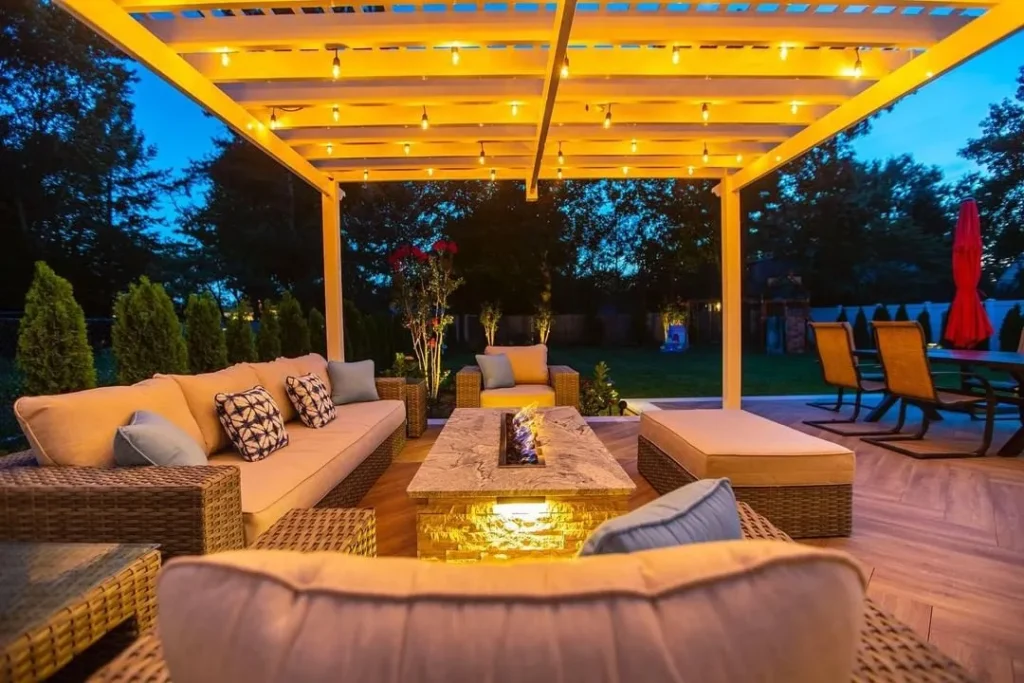What is a Covered Patio?
A covered patio is an outdoor living space that is covered by a roof or awning to protect it from the elements. It’s a popular choice for those who want to enjoy the outdoors while still being protected from the sun, wind, and rain. A covered patio can be attached to a house or freestanding and can be made from a variety of materials like wood, metal, or concrete.
Having a covered patio allows you to extend the usable space of your home into the outdoors. It’s a great place to entertain guests, relax with family, or enjoy a meal outside. It can also increase the value of your home and provide a great return on investment.
When designing a covered patio, it’s important to consider the style and materials used in the construction. You will want to choose materials that are durable and weather-resistant, and that will blend well with the overall look of your home. It’s also important to consider the size and layout of your patio to ensure that it’s functional and comfortable.
Overall, a covered patio is a wonderful addition to any home. It provides a space for outdoor living without sacrificing comfort and protection from the elements. With the right design and construction, you can create a beautiful and functional outdoor living space that will enhance your home and lifestyle for years to come.
Benefits of a Fire Pit Under a Covered Patio
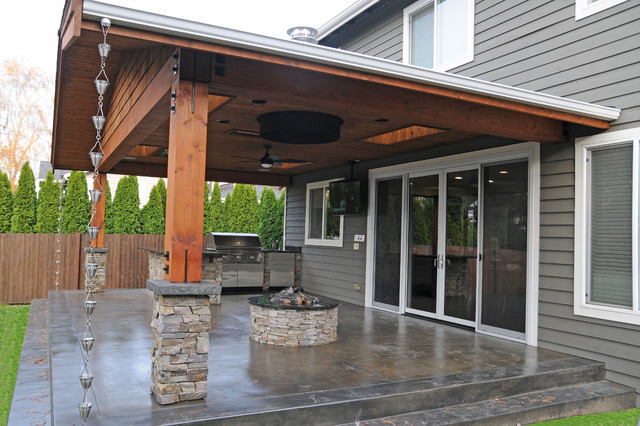
Fire pits are a great way to add warmth and ambiance to your outdoor living space. They provide a focal point for gatherings with friends and family, and can even increase the value of your home. But can you put a fire pit under a covered patio? The answer is yes, and there are several benefits to doing so.
First and foremost, having a fire pit under a covered patio allows you to use your outdoor space more often. Even on cooler or rainy days, you can still enjoy the warmth and comfort of a fire pit without being exposed to the elements. This means you can enjoy your outdoor living space throughout the year, rather than just during the summer months.
Additionally, having a covered patio provides added protection for your fire pit and reduces the risk of damage. Rain, snow, and other weather can wear down your fire pit over time, but being covered will help to preserve its lifespan. It’s also important to note that a covered patio can prevent the buildup of toxic smoke that can occur with propane and wood-burning fire pits. This ensures that you and your guests can enjoy the fire pit safely and without concern.
Aside from the practical benefits, a fire pit under a covered patio also adds ambiance to your outdoor living space. The warm glow of the fire will create a cozy and inviting atmosphere, making your covered patio the perfect spot for relaxing and entertaining.
When installing a fire pit under a covered patio, it’s important to consider the necessary safety precautions, such as proper ventilation and minimum clearance requirements. You should also choose fire-resistant materials and be mindful of any flammable objects nearby. However, with the proper planning and safety measures in place, having a fire pit under a covered patio can provide numerous benefits and enhance your outdoor living space.
Safety Considerations

When it comes to adding a fire pit to your covered patio, safety considerations should be a top priority. While it can be a great addition to your outdoor living space, it can also be a recipe for disaster if not installed and used correctly.
One of the most important safety considerations is proper ventilation. Make sure that your covered patio has plenty of ventilation to allow for proper airflow and avoid the accumulation of toxic smoke. It’s also crucial to ensure that your patio cover is made from fire-resistant materials to help reduce the risk of fire.
The location of your fire pit is also important. It should be placed on a level surface away from any flammable materials or structures. Additionally, make sure to follow the proper clearance requirements as directed by the fire pit manufacturer. This includes maintaining proper distances from walls, ceilings, and other structures.
If you decide to use a wood-burning fire pit, be sure to only use dry and seasoned wood. Wet or green wood can create excess smoke and increase the risk of carbon monoxide poisoning. Propane fire pits are a popular alternative that eliminate the need for wood, but it’s important to follow all safety instructions and keep propane tanks away from the fire.
Portable fire pits can be a convenient option, but it’s important to only use them on non-combustible surfaces such as concrete or brick. Using them on composite or wooden decks can lead to potential fires and serious damage.
Overall, adding a fire pit to your covered patio can be a great way to enhance your outdoor living space, but it’s crucial to prioritize safety considerations. Following the proper guidelines and taking necessary precautions will allow you to enjoy your fire pit safely and worry-free.
Flammable Materials

When it comes to outdoor living spaces and fire pits, safety should always be the top priority. One of the most important safety considerations is the presence of flammable materials in and around the area where your fire pit will be located.
Flammable materials include things like wood, paper, leaves, and other debris that can easily catch fire. These materials should be kept at a safe distance from your fire pit to reduce the risk of accidental fires.
For example, if you have a wooden deck or patio, it’s important to ensure that your fire pit is placed on a non-combustible surface such as concrete. This will help prevent any sparks or embers from igniting the wooden surface, which could lead to a potentially devastating fire.
In addition to the surface underneath your fire pit, it’s important to consider any overhead structures such as a patio roof or pergola. These structures may be constructed of flammable materials such as wood or vinyl, which can also pose a fire hazard.
To reduce the risk of a fire, make sure to follow the recommended clearance requirements for your specific fire pit. This includes maintaining a safe distance from any structures or materials that could ignite.
Finally, it’s important to never leave a fire pit unattended, especially when there are flammable materials nearby. Always extinguish the fire completely using water or sand before leaving the area.
By taking these precautions and being aware of the potential dangers of flammable materials, you can safely enjoy your outdoor living space and fire pit for years to come.
Proper Ventilation
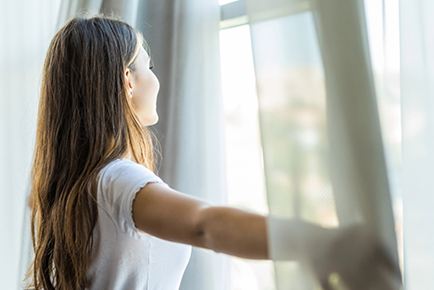
Proper ventilation is a crucial aspect of any indoor or outdoor space that features a fire pit. Without adequate ventilation, dangerous levels of carbon monoxide and other toxic smoke can build up, posing a serious health hazard to those nearby.
When it comes to an outdoor fire pit, proper ventilation can be achieved by choosing a location that is open and spacious. If you plan to install a fire pit under a covered patio, ensure the patio has plenty of ventilation to allow smoke to dissipate quickly. This can be accomplished by installing fans or an overhead hood that sucks up smoke and vents it outside.
It’s also important to consider the ceiling height of your covered patio. The higher the ceiling, the more space there is for smoke to rise and dissipate. A high ceiling also reduces the risk of damage to the patio roof from the heat and smoke produced by the fire pit.
For indoor fire pits, proper ventilation is even more critical. Installing a vent hood above the fire pit can help remove smoke and other harmful fumes from the room. Alternatively, opening windows or doors can also increase ventilation and reduce the risk of carbon monoxide poisoning.
In addition to ensuring proper ventilation, it’s also crucial to follow all manufacturer’s instructions and safety guidelines when using a fire pit. This includes using the correct type of fuel (wood, charcoal, gas), keeping the fire at a safe distance from flammable materials, and never leaving the fire pit unattended.
In conclusion, proper ventilation is essential when using a fire pit in both indoor and outdoor settings. By ensuring adequate ventilation and following safety guidelines, you can enjoy your fire pit safely and comfortably.
Level Surface
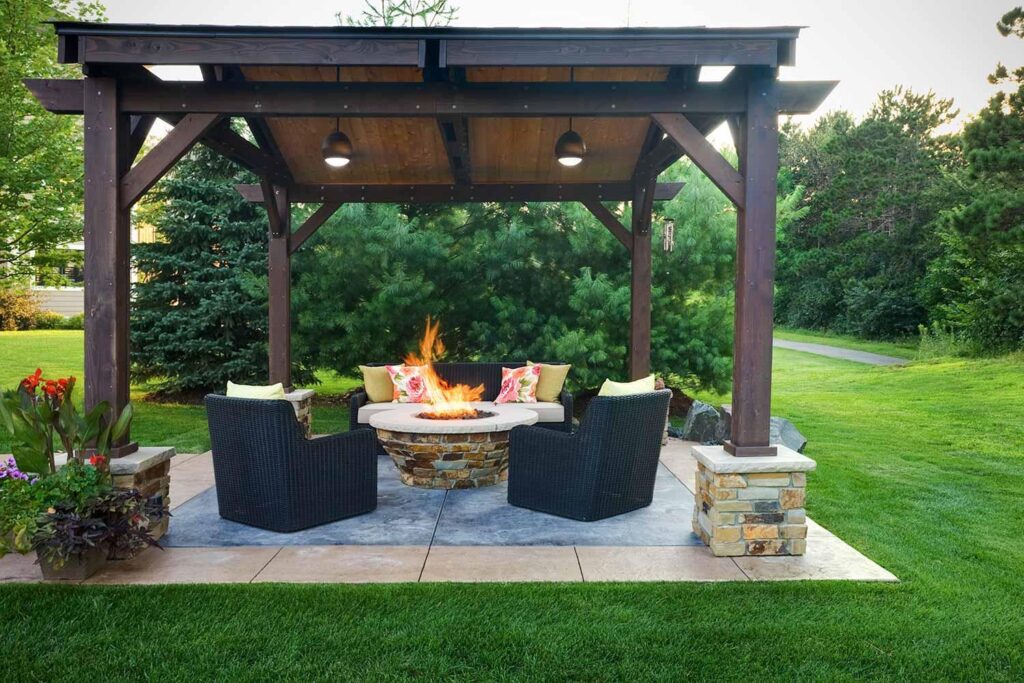
Having a level surface is crucial when it comes to any outdoor structure or furniture, including fire pits. A level surface provides stability and helps prevent the fire pit from tipping over, which can lead to potential fires and injuries.
When installing a fire pit, it’s important to choose a location with a level surface. This can be achieved by using a level tool, such as a carpenter’s level, to ensure the surface is even. If the surface is not level, you may need to add or remove soil to create a flat area.
Using pavers or a concrete pad is another option to create a level surface for a fire pit. This can also provide protection for the underlying surface, such as grass or soil, from heat and flames.
Not only does a level surface provide safety and stability for the fire pit, but it also helps with proper air flow. A fire pit situated on uneven ground can create uneven air flow, leading to an uneven burn and the potential for excess smoke. A level surface can help mitigate this issue and provide a more enjoyable fire pit experience.
It’s important to note that the proper distance between the fire pit and any surrounding structures, including your home, also needs to be considered alongside with the level surface. When in doubt, consult with a professional or check with local regulations to ensure that you have a safe, level surface for your outdoor fire pit.
Safe Distances from Combustible Materials
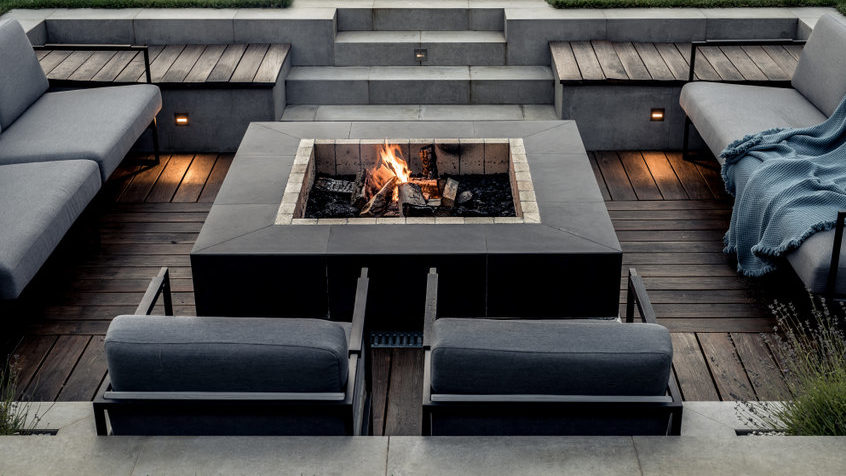
When installing a fire pit in your outdoor living space, one of the most critical safety considerations is the distance between the fire pit and any combustible materials. This includes objects such as patio covers, ceiling height, vinyl flooring, wooden deck, composite deck, and even nearby trees and shrubs.
According to the National Fire Protection Association (NFPA), a fire pit must be at least 10 feet away from any combustible materials. This minimum distance can vary depending on the type of fire pit you have, as well as the materials used in the construction of your outdoor space.
For wood-burning fire pits, it’s important to consider the type of wood you’ll be using as this can affect the heat and intensity of the flames. Softwoods such as pine and cedar burn hotter and faster than hardwoods, which means they require a greater distance from combustible materials.
Propane fire pits, on the other hand, require a different set of considerations. While they don’t produce sparks and potentially toxic smoke like wood fires, it’s essential to keep them at a safe distance from wooden structures such as a deck or roof. It’s also crucial to ensure proper ventilation to prevent the buildup of carbon monoxide.
It’s also important to note that fire pit clearance requirements can vary depending on the specific rules and regulations in your local area. You should check with your local fire department to ensure you are following all safety codes and guidelines.
In addition to ensuring safe distances from combustible materials, it’s also essential to follow proper safety precautions when using your fire pit. This includes keeping a fire extinguisher or another type of fire suppression device nearby, avoiding using accelerants such as gasoline to start fires, and never leaving your fire pit unattended.
Installing a fire pit in your outdoor living space can be a great way to create a cozy and inviting atmosphere for friends and family to gather. However, it’s vital to follow all safety guidelines and best practices to ensure that your fire pit doesn’t become a recipe for disaster. By keeping a safe distance from combustible materials and following proper safety precautions, you can enjoy your outdoor fire pit with peace of mind.
Ceiling Height and Overhead Clearance Requirements
Ceiling height and overhead clearance are crucial factors to consider when installing a fire pit under a covered patio. According to the NFPA, the minimum clearance between the top of a fire pit and any overhead combustible material should be at least 7 feet. However, it’s important to keep in mind that this is just a minimum requirement and may vary depending on the type of fire pit you have and the materials used in your outdoor space.
For example, if you have a gas fire pit or a propane fire pit table, the minimum clearance may differ than that of a wood-burning fire pit. Gas and propane fire pits tend to produce less smoke and sparks compared to wood fires, which makes them less hazardous in terms of overhead clearance requirements. However, it’s still essential to follow the manufacturer’s guidelines and to check with your local fire department to determine the appropriate clearance requirements for your specific type of fire pit.
Ceiling height is also an important factor to consider. The distance between the top of a fire pit and the ceiling should be at least 2 feet to allow for proper ventilation and prevent the buildup of toxic smoke and carbon monoxide. It’s important to ensure that the ceiling material is fire-resistant to minimize the risk of damage in case of a fire.
In addition to minimum clearance requirements and proper ceiling height, it’s also crucial to maintain a level surface and ensure that the patio cover is sturdy and secure. Any flammable materials such as vinyl flooring or wooden deck should be avoided in the immediate area surrounding the fire pit.
When installing a fire pit under a covered patio, it’s important to take all necessary precautions to ensure the safety of you and your loved ones. By following clearance requirements, ensuring proper ventilation, and using fire-resistant materials, you can create a safe and enjoyable outdoor living space.
Types of Fire Pits Suitable for Use in A Covered Patio
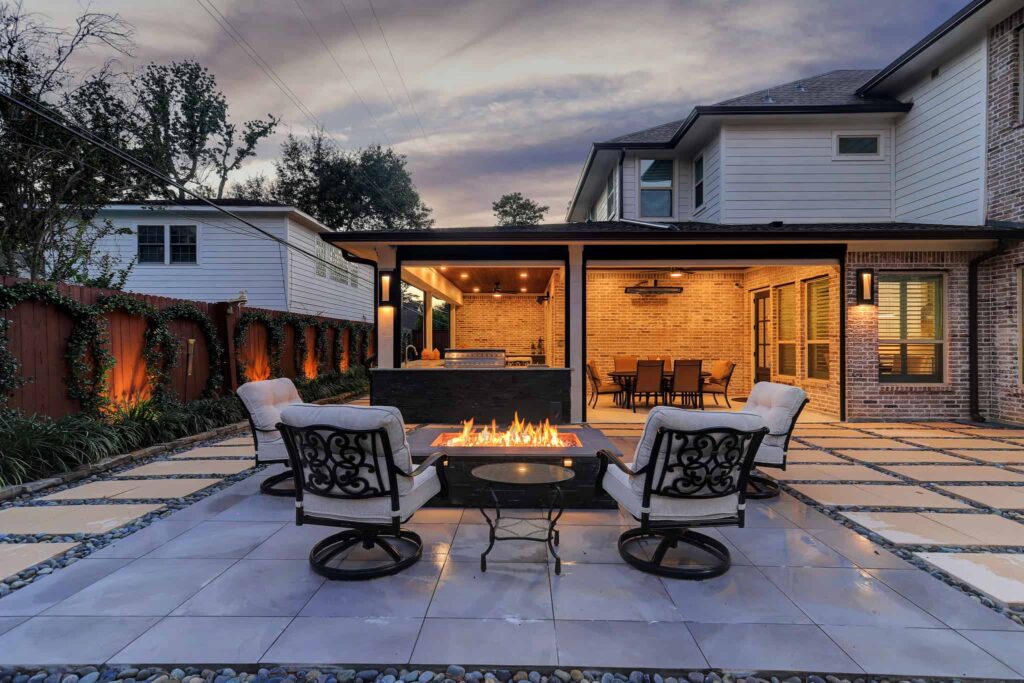
A covered patio can be an excellent place to relax and unwind, especially when you have a fire pit. But when it comes to choosing a fire pit for your patio, there are different types to consider depending on your needs and preferences.
Gas fire pits are one of the most popular options for use on a covered patio. They come in a variety of shapes, sizes, and styles, and are available as freestanding units or built into tables. One of the best things about gas fire pits is that they are easy to start and control, and they emit less smoke and fewer embers than wood-burning fire pits. Gas fire pits are also relatively low maintenance, have no ashes to clean up, and don’t require you to store firewood.
If you prefer the ambiance of a wood-burning fire, you can also consider a wood-burning fire pit. These types of fire pits provide a traditional bonfire appeal that many people love. To use a wood-burning fire pit in your covered patio, you need to have adequate ventilation and proper clearance. It’s also essential to choose a fire pit that has a spark screen to prevent embers from escaping and causing hazards.
Propane fire pits or tables are another option. They operate similarly to gas fire pits but are typically larger and can provide a warming flame over a much larger area. Just like gas fire pits, propane fire pits are easy to start, control, and don’t produce smoke. One of the main benefits of using a propane fire pit is they produce a large flame, making them perfect for gatherings and social events.
Another option is portable fire pits, which are ideal for covered patios that don’t have a permanent fire pit feature. Portable fire pits come in various shapes, sizes, and designs, and can be either gas-fueled or wood-burning. These fire pits typically come with a spark screen and do not require permanent installation.
In summary, when looking for a fire pit for your covered patio, you have several options to choose from. It’s important to consider your specific needs and preferences and choose a fire pit that is appropriate for your outdoor space and meets all safety requirements. With proper ventilation, clearance, and safety precautions, a fire pit can be an excellent addition to enhance the ambiance of your outdoor living space.
Portable Fire Pits
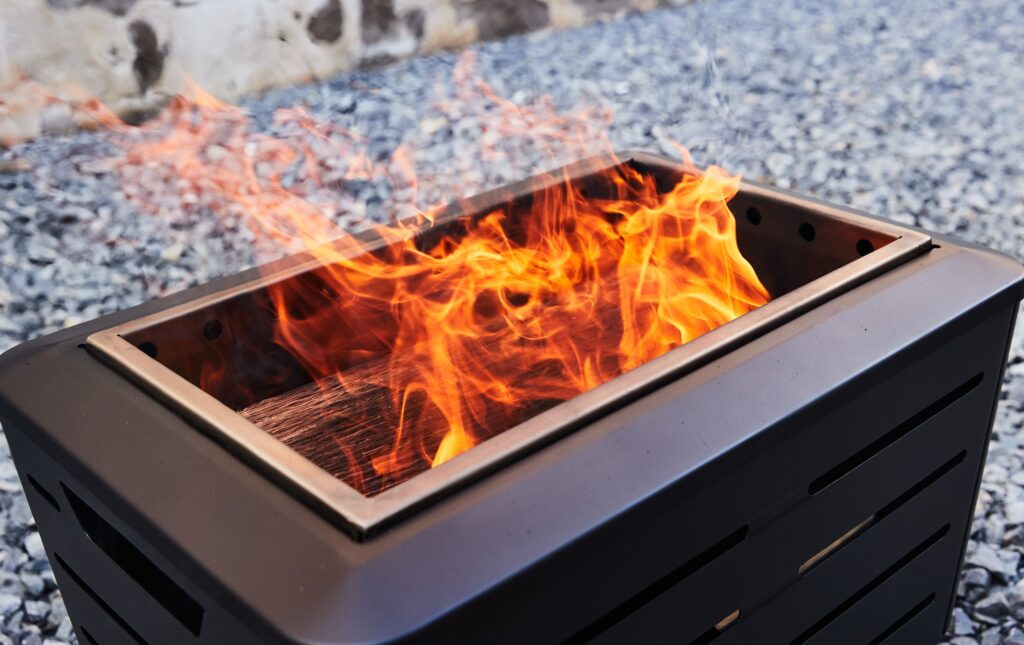
Portable fire pits have become increasingly popular in recent years, and it’s easy to see why. These fire pits offer flexibility and convenience to those who want to enjoy a cozy fire while relaxing on their patio or in their backyard.
One of the biggest advantages of portable fire pits is that they are easy to move around. If you are someone who likes to change your outdoor space around frequently, then a portable fire pit may be the perfect addition to your patio or backyard.
Portable fire pits are also a great option for those who don’t have a fixed location for a fire pit. Depending on where you live, some municipalities may have fire pit restrictions, and a portable fire pit can be an excellent solution to stay within the regulations.
Another advantage of portable fire pits is that they are relatively easy to set up. They require little to no installation, and most models don’t require more than adding some firewood or hooking up a propane tank. This means that you can set up a fire pit in a matter of minutes and start enjoying the warmth and ambiance right away.
There are two types of portable fire pits: gas-fueled and wood-burning. Gas-fueled fire pits are more convenient to use since they require no wood or charcoal. Instead, you need to connect the fire pit to a propane tank, and you are ready to go. Wood-burning fire pits offer a more traditional option, and many people enjoy the smell and sound of burning wood.
Another important consideration when it comes to portable fire pits is safety. It’s essential to place the portable fire pit on level ground and away from any flammable materials. You should also make sure to follow the manufacturer’s instructions about clearance requirements and proper ventilation.
In conclusion, portable fire pits are an excellent addition to any outdoor living space. They provide the warmth and ambiance of a traditional fire pit, with the added benefit of being easy to move around and set up. Whether you prefer a gas-fueled or wood-burning fire pit, portable options offer convenience and flexibility for you to enjoy. Remember to always follow proper safety precautions when using a portable fire pit to ensure a safe and enjoyable experience.
Preparation for Installing a Fire Pit Under Your Covered Patio
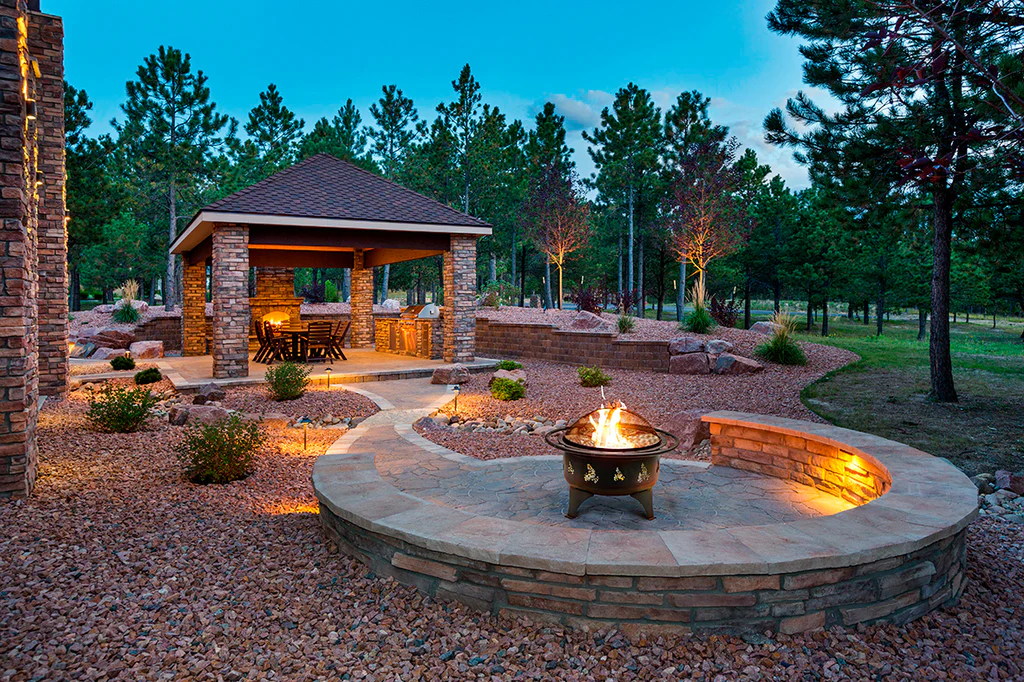
Installing a fire pit under your covered patio can be a great way to create a cozy and inviting outdoor living space. However, before you start planning the perfect spot for your fire pit, there are several important things to consider. Proper preparation is key to ensuring a safe and enjoyable outdoor living area.
Firstly, it is important to understand the type of fire pit that is appropriate for your patio. Gas fire pits and propane fire tables are a popular choice for covered patios, as they emit less toxic smoke and require minimal clearance with the patio ceiling. Wood-burning fire pits are an alternative, providing a warm and crackling ambiance, but they may require more overhead clearance and better ventilation.
Secondly, you need to ensure that your patio can handle the weight and size of the fire pit you choose. A level surface is necessary to avoid dangerous tipping and to maintain a stable fire pit. Additionally, the structure of your patio cover should be able to withstand the heat and potential risk of damage from the fire pit. A concrete patio or a brick or stone patio cover is an ideal and fire-resistant option.
Another important aspect to consider is ventilation. Your covered patio should have plenty of ventilation to prevent toxic smoke buildup and carbon monoxide poisoning. Even with a gas-fueled fire pit that produces minimal smoke, proper ventilation is crucial for optimum safety.
Finally, it is important to adhere to the proper safety precautions to prevent potential fires. Your fire pit should be placed away from any flammable materials, such as wooden patio furniture or vinyl flooring. It should also maintain a minimum distance, as required by the manufacturer’s instructions, from any overhead clearance, including the patio roof or any combustible materials.
With proper preparation, installing a fire pit under your covered patio can be a wonderful addition to your outdoor living space. Ensuring proper weight, size, ventilation, and clearance requirements for the fire pit you choose is key to creating a safe and enjoyable ambiance for all.
Check Local Building Codes and Regulations
When it comes to creating or renovating a building, many people focus on the design and aesthetics of the space without giving much thought to local building codes and regulations. However, it is important to remember that adhering to these codes is crucial for safety and legal reasons.
Every city and state has its own building codes and regulations that dictate the standards for construction, safety, and occupancy of buildings. These codes are put in place to ensure that buildings are safe, accessible, and functional for their intended purpose. Failure to comply with these codes can result in fines and, in some cases, legal action.
When planning a new construction project or renovation, it is important to check your local building codes and regulations to ensure that your project is in compliance. This includes obtaining all necessary permits and approvals, meeting minimum safety requirements, and complying with zoning regulations, fire codes, and electrical codes.
Some common regulations that may impact your project include requirements for fire exits, handicap accessibility, and electrical wiring. For example, commercial buildings may be required to have a certain number of exits based on the size and layout of the space. Similarly, buildings must be designed and constructed in a way that allows for easy access for people with disabilities.
It is also important to keep in mind that building codes and regulations are updated periodically to reflect changes in technology, safety standards, and environmental concerns. Staying up-to-date on these changes can ensure that your building is compliant and safe.
In conclusion, checking and adhering to local building codes and regulations is essential for any construction or renovation project. Not only does it ensure the safety of the building and its occupants, but it also protects you from potential legal consequences. So before you begin your next project, take the time to research and comply with all relevant building codes and regulations.

